
Malignant Fibrous Histiocytoma of the Larynx: Successful Treatment with CO2 Laser Microsurgery
*Corresponding Author(s):
Luis Humberto Jiménez FandiñoDepartment Of Otolaryngology, Pontificia Universidad Javeriana, Hospital Universitario San Ignacio, Bogotá, Colombia
Tel:+ 57 3158304596,
Email:lhjimenez@husi.org.co
Abstract
Malignant Fibrous Histiocytoma (MFH) of the larynx is a very uncommon entity with very few cases reported in the literature. So far, there is no established treatment modality. We report the case of a 56-year-old woman with malignant fibrous histiocytoma of the right vocal cord with recurrence after the first surgical intervention. Successful treatment was accomplished with transoral laser microsurgery. There was no need of adjuvant therapy. No recurrence has been reported for two and a half years follow up. We conclude that surgical treatment alone can be successful when treating MFH of the larynx, even in cases of recurrence.
Keywords
CO2 Laser Cordectomy; Glottic sarcoma; Malignant Fibrous Hystiocytoma (MFH); Vocal Cord Cancer
INTRODUCTION
Head and neck sarcomas correspond to less than 1% of the neoplasms in this region. They are more frequent in men than in women and present at an advanced age. They are derived from mesodermal tissue and are classified according to their location. Sarcomas in the larynx are very rare, representing less than 1% of laryngeal neoplasms and there are few cases reported in the literature with variations regarding their characteristics, behavior and treatment [1].
Therefore, it is intended to show the case of a patient with a high-grade Malignant Fibrous Histiocytoma (MFH) of the larynx, who was diagnosed and treated early with a successful surgical resection.
CASE REPORT
A 56-year-old female patient with no relevant history, complained of eight months of dysphonia, with subsequent onset of medium effort dyspnea. It was not associated to gastroesophageal reflux symptoms and no history of orotracheal intubation.
Flexible nasolaryngoscopy documented a lesion with polypoid characteristics in the anterior and middle third of the right vocal cord (VC) that prevents complete glottic closure. Stroboscopy showed a large mass of granulomatous and solid appearance that compromises right VC entirely, with incomplete glottic closure, loss of vibratory activity and decreased airway permeability (Figure 1). Extension studies were taken and a Computerized Tomography (CT) of the neck showed a round mass of irregular borders at the level of the glottis, which decreases airway lumen by 80% without compromising cervical nodes (Figure 2).
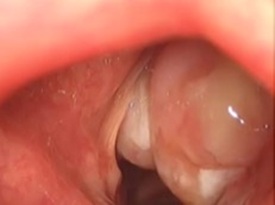 Figure 1: Laryngeal stroboscopy that shows a large mass of granulomatous appearance that compromises right vocal cord.
Figure 1: Laryngeal stroboscopy that shows a large mass of granulomatous appearance that compromises right vocal cord.
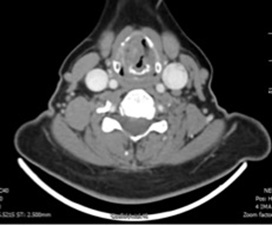 Figure 2: CT axial. Irregular mass that compromises airway lumen by 80%.
Figure 2: CT axial. Irregular mass that compromises airway lumen by 80%.
The lesion was initially treated by type II microlaryngeal surgery with robotic CO2 laser. The sample size was 2x1.6x0.6 cm. The histopathological study reported two different type of cells; hyperchromatic bizarre fusiform shaped cells and large polygonal cells with vesicular nuclei and prominent nucleoli in background of abundant collagenous stroma. The immunohistochemical analysis was positive for vimectin and CD68, considered histiocyte markers that allow making a differential diagnosis with spindle-shaped cell sarcoma (Figure 3).
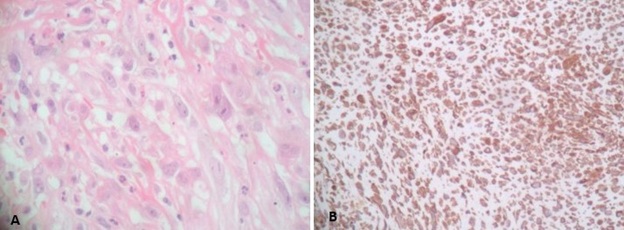 Figure 3: A. Histopathology: Large polygonal cells with prominent nucleoli. B. Immunohistochemistry: Positive for CD68.
Figure 3: A. Histopathology: Large polygonal cells with prominent nucleoli. B. Immunohistochemistry: Positive for CD68.
One month after the initial resection, the follow up stroboscopy evidenced a residual lesion (Figure 4). Extension studies were negative. In a second intervention, a wide resection was performed with a Va ipsilateral cordectomy with robotic CO2 laser. The pathology sample measured 1.3x1x0.7 cm, microscopic description was consistent with previous findings, which confirmed the initial diagnosis and reported tumor free margins.
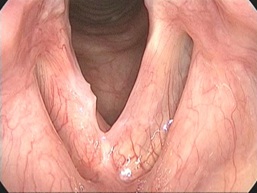 Figure 4: Two months follow up stroboscopy with evidence of residual tumor.
Figure 4: Two months follow up stroboscopy with evidence of residual tumor.
Follow-up is carried out with stroboscopy since the second intervention for two and a half years. There was no evidence of recurrence. Stroboscopy showed an anterior synechia (Figure 5).
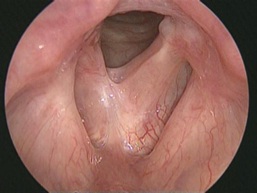 Figure 5: Two year follow up stroboscopy without evidence of recurring tumor. Anterior synechia.
Figure 5: Two year follow up stroboscopy without evidence of recurring tumor. Anterior synechia.
DISCUSSION
The MFH is an extremely rare tumor and so far, there are very few cases reported in the literature. They can occur as sessile or polypoid masses, as is the case of the patient, although they are more frequent in men between the third and fourth decades of life [1].
In the literature review, very few cases of MFH of the larynx with no association to radiotherapy were found. We report a new case that was successfully treated with CO2 laser microlaryngeal surgery, without the need for adjuvant or postsurgical radiotherapy or chemotherapy [2-4]. It is the first case reported in Latin America to our knowledge.
In the case presented, it manifested as a large polypoid-looking mass compromising right VC and decreasing airway permeability.
The clinical presentation of sarcomas in the larynx is earlier than in other head and neck sarcomas given its mechanical effect. Usually, the first symptom to appear is dysphonia and can further present with stridor or dyspnea as was the case of our patient [2].
They are rarely invasive, which allows for an adequate surgical resection in most cases. Depending on its size, it can be resected through an endoscopic approach or more frequently, with more aggressive techniques such as total or partial laryngectomy, or partial cricotracheal resection [5,6].
In the case reported, the final diagnosis was confirmed with the histopathological analysis of the lesion. Tumor cells were positive for vimectin and CD68, considered histiocyte markers that allow to make a differential diagnosis with spindle-shaped cell sarcoma [7].
The use of radiotherapy has been reported in high-grade tumors, positive surgical margins, tumors larger than 5cm and recurrent lesions [1]. Nonetheless, in the case described, the patient presented a residual lesion that led to a second surgical intervention where tumor-free margins were obtained. There was no need for chemotherapy or adjuvant radiotherapy.
In our experience, the CO2 laser microlaryngeal approach can be effective in early lesions of the larynx as a single treatment.
The prognosis depends mainly on the presence of vascular invasion, the size of the tumor and the grade of differentiation. An approximate survival rate of 60% at 5 years and 40% at 10 years has been reported [2,8].
In the case presented, at two and a half years of follow up, the patient remains recurrence free.
CONCLUSION
Given the low rate of sarcomas in the larynx there is no consensus regarding its staging and treatment. In our experience and some cases reported in the literature, the transoral microsurgical approach with robotic CO2 laser was successful; however, it requires long-term follow-up.
In order to establish a standardized treatment, more evidence is required about the success of surgical management as a single treatment in laryngeal sarcomas.
FINANCIAL DISCLOSURE
There are no financial conflicts of interest to disclose.
CONFLICT OF INTEREST
The authors of this article hereby declare not having any conflict of interest.
ETHICAL CONSIDERATIONS
The authors of this article hereby declare that the manuscript has the informed consent of all the subjects studied herein.
REFERENCES
- Liu CY, Wang MC, Li WY, Chang SY, Chu PY (2006) Sarcoma of the larynx: treatment results and literature review. J Chin Med Assoc 69: 120-124.
- Testa D, Motta S, Marcuccio G, Paccone M, Rocca A, et al. (2016) Our experience in the treatment of Malignant Fibrous Hystiocytoma of the larynx: clinical diagnosis , therapeutic approach and review of literature 11: 208-214.
- Kuwabara H, Saito K, Shibanushi T, Kuwahara T (1994) Malignant Fibrous histiocytoma of the larynx. Eur Arch Otorhinolaryngol 251: 178- 182.
- Bilewicz R, Wierzchowska M, Burduk PK, Szukalski J (2007) Malignant fibrohistiocytoma of the larynx. Otolaryngol Pol 61: 325- 328.
- Stavrakas M, Nixon I, Andi K, Oakley R, Jeannon JP, et al. (2016) Head and neck sarcomas: clinical and histopathological presentation, treatment modalities, and outcomes. J Laryngol Otol 130: 850-859.
- Cao X, Liu J, Zheng Y, Li Q, Teng Y, et al. (2012) Simultaneous squamous cell carcinoma with primary malignant fibrous histiocytoma of the larynx: A case report. Molecular Medicine Reports 5: 971-973.
- Anghelina F, Ionit?a? E, Chiut?u L, Mogoanta? CA, Ciolofan S, et al. (2008) Malignant fibrous histiocytoma of larynx with giant cell: Case report and histological-clinical considerations. Rom J Morphol Embryol 50: 481-485.
- Goldblum JR (2014) An approach to pleomorphic sarcomas: can we subclassify, and does it matter? Modern Pathology 27: S39-S46.
Citation: Gutiérrez-Gómez E, Echeverri MCV, Ronderos-Suárez ÁM, Jiménez-Fandiño LH (2020) Malignant Fibrous Histiocytoma of the Larynx: Successful Treatment with CO2 Laser Microsurgery. J Otolaryng Head Neck Surg 6: 39
Copyright: © 2020 Elisa Gutiérrez Gómez, et al. This is an open-access article distributed under the terms of the Creative Commons Attribution License, which permits unrestricted use, distribution, and reproduction in any medium, provided the original author and source are credited.

